Kaffir lime leaves, highly recognisable with their double leaves, are an essential ingredient all across South East Asia and not just in Thai, Indonesian and Cambodian cuisines!
Estimated reading time: 8 minutes
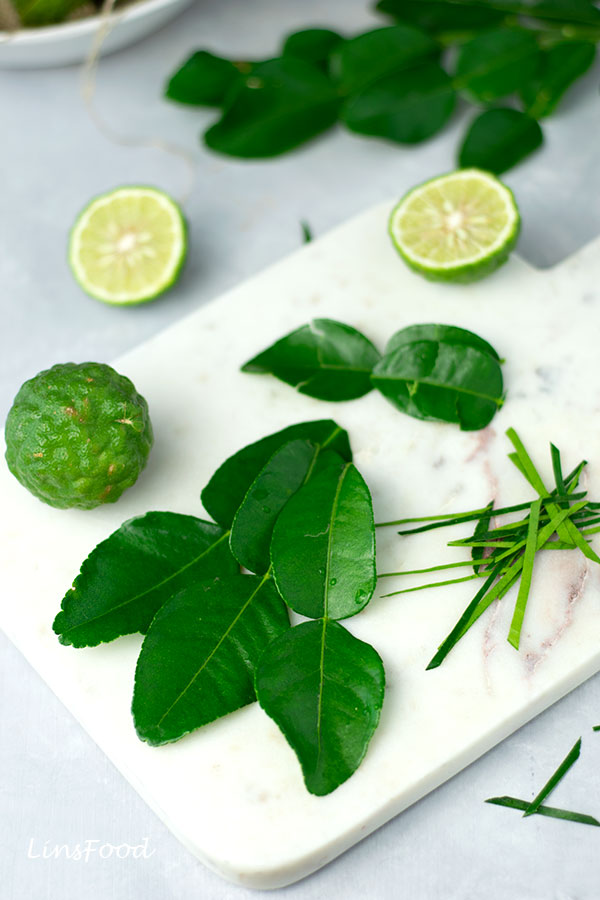
What are Kaffir Limes?
I shall talk about the leaves and how to use them below but let’s just briefly look at the kaffir lime fruit itself and how to use it.
Kaffir lime, citrus hystrix is a lime that’s native to South East Asia and is easily identified by its knobbly skin. Some other names for the kaffir lime:
- makrut limes
- bai makrut in Thai
- limau purut in Malay (limau = lime/lemon)
- jeruk purut in Indonesian
- kabuyaw or kulubot in Tagalog (Filipino lingo)
- lá chanh in Vietnamese
- Combava and Papeda in parts of the Indian Ocean
What about the Juice?
It’s probably about the same size as your regular lime. The difference here is that we don’t use the kaffir lime juice in cooking because it definitely, definitely leans on the bitter side. And there isn’t a whole lot of juice to begin with, as in regular limes.
Makrut lime juice is traditionally used for medicinal purposes, in shampoos, in baths and the like. I certainly remember the juice or slices of kaffir lime being dropped into baths because they’re supposed to be nourishing for the skin.
Aromatherapy and cosmetic industries also prize kaffir lime essential oil.
For culinary purposes, we use the kaffir lime zest, or the rind of the fruit itself, without the bitter white pith. As well as making Thai curry pastes, the rind and zest of the fruit are delicious in salads and sambals.
Just like in this Kaffir Lime Kosho I made not too long ago, a Japanese fusion spicy condiment.
To use the Kaffir lime skin, just use a citrus zester or grater to get thin slices or bits of peel. Go easy on how much you use, as too much can leave a bitter aftertaste in your dishes. See attached video.

How to Use Kaffir Lime Leaves?
Kaffir lime leaves are highly priced for their citrusy and strong flavour and aroma. They also have a hint of pepper, and something you have to bear in mind, a bitter aftertaste, just like the kaffir lime zest.
You can use them raw or cook them in curries, stir fries, soups and also to flavour rice and other grains.
Use them Raw
So if you’re using your kaffir lime leaves raw, you want to slice them up thinly or chop them up small before adding to salads and sambals. This is because these leaves are bitter when consumed raw, despite their fragrance. So you definitely want to go easy on how much you use. Because you don’t want this highly aromatic, but a little bitter, herb, to overpower whatever dish you’re using it in.
And this is how you use the leaves raw. Essentially you cut the leaves on either side of that harder, tougher middle vein and then you just slice them up thinly. You could even chop them up fine and then add them to your salads and your sambals, or even just to flavour up things like salad cream and mayonnaise.
How to Cook with Kaffir Lime Leaves
If you’re using the leaves whole, just tear on either side of that vein, one or two tears, and drop it into your stew, your soup, your curries, whatever. The tear, like rubbing leaves, releases the fragrance better.
What I like to do is reserve a couple of the leaves to be dropped about 5 minutes from the end of cooking time. This way, your dish will have the strongest perfume from the leaves. This is optional, and I don’t always do it.
You don’t consume whole kaffir lime leaves. So just place them to the side when eating. There is no need to fish them out of the pot after cooking.
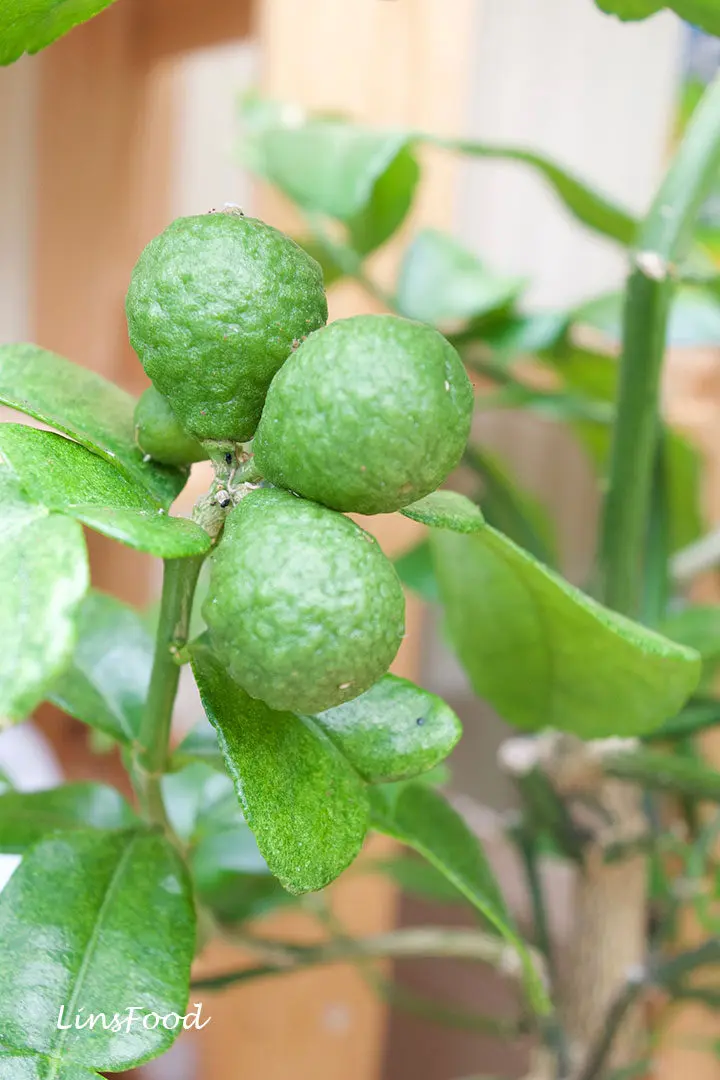
Where can you buy the Leaves?
If you’re in the UK, you’ll be pleased to know that many of our larger supermarkets do supply fresh kaffir lime leaves. I know that Waitrose do them, I shop with Ocado and I know that Ocado supplies them as well.
Depending on where you are in the world, if there is an Asian supermarket near you, that would be the place to try, whether East Asian, South or South East Asian. Or, as I always say, go online. Especially since the world came to a standstill some years ago, so many online sellers have sprung up supplying exotic ingredients.
How to store fresh Kaffir Lime Leaves?
So the best way to store them and ensure their freshness is to freeze any extra that you have. To use, just get them out of the freezer, rinse and proceed as the recipe dictates. The leaves don’t remain frozen for long once out of the freezer.
I’ve had a kaffir lime plant (or 3) for over 20 years. I’ve always described one of them as a monster, as it is far too happy and grows like crazy. I struggle to use it quickly enough and am always having to prune it and most of the leaves end up in the freezer, with my students, my clients and in vodka!
Flavouring vodka is one of my favourite ways of using up kaffir lime peel and the leaves. Sometimes I drop some bruised lemongrass and pieces of fresh galangal in there too, as these are all great accompaniments to kaffir lime leaves.
Kaffir Lime Leaves Substitute
There are no substitutes for kaffir lime leaves. No matter how creative you get. Nothing, nada, zilch is going to replicate that sharp, citrusy, with a hint of bitter, scent of these precious leaves.
Bay leaves, curry leaves, mint, lemon – sorry guys, no can do. Take it from a lifelong user of kaffir lime leaves. And grower, because my grandma always had a plant.
So what can you do if you can’t find makrut lime leaves? Leave them out and just use a little zest from any lime you happen to have. It’s not a substitute, but at least you’re getting some sort of a citrus hit.

How to grow Makrut Lime?
As mentioned above, I’ve been growing kaffir lime for a couple of decades. Because I live in the UK, I’ve always grown them pots. The makrut lime is from tropical South East Asia, so it doesn’t like cold weather.
I take my pots out only in the months of May, June, July and August. But I have a conservatory where all my tropical herbs and chillies tend to live year round.
If you haven’t got a conservatory (sun room), a sunny windowsill will do perfectly. The oldest of my plants started out in a medium-sized pot on my windowsill in London in the 90s. While the kaffir lime tree loves plenty of sunlight, be careful of scorching sunlight through glass – your leaves will burn.
One down side of keeping the makrut lime indoors is the presence of red spider mites. As long as you stay on top of them, you should be fine.
The only other problem I’ve encountered in all the years of growing this lime tree is scale insects, which is a common citrus pest. Just pick these guys off as soon as you see any and wipe down the affected leaf or branch/stem or petiole.
Where to Buy Kaffir Lime Plants
A simple search online will give you a few options. But I know that in the US, there are different state laws regarding the import and selling of various citrus plants.
Here in the UK, my trusted supplier is Colonial Growers. I’ve bought a few plants from them over the years; a couple for myself and the rest as gifts. In fact, at the time of writing (Feb 2023), I’m about to get another one as a housewarming gift for a friend!
FAQs
Are dried Kaffir lime leaves any good?
The dried leaves like dried lemongrass and galangal are not as strong in aroma as the fresh leaves. So double or triple the number that your recipe calls for.
What is kaffir lime called now?
In recent years, there has been a strong inclination (more in the US than anywhere else) towards using the name makrut lime instead of Kaffir lime because of its religious and racial connotations in South Africa.
I grew up calling it kaffir lime and that’s what we still call it in English in Singapore and Malaysia.
Is Bergamot and kaffir lime the same?
No, bergamot (citrus bergamia) and kaffir (citrus hystix) limes are not the same. While they both have bumpy skin, bergamot is the size of an orange and ripens to a yellow colour. It is perhaps most famous as the flavour of Earl Grey tea.
How can you tell a kaffir lime?
Kaffir limes have a bumpy and knobbly skin, with double leaves.
Is kaffir lime the same as Key lime?
No, they are 2 different kinds of limes. The key lime is much smaller and similar in appearance to the Calamondin.
Recipes using Kaffir Lime Leaves
I have many, many recipes that use kaffir lime leaves both here on SMR, as well as on LinsFood. Just hit the Thai & Vietnamese Recipes page on LinsFood for some ideas. And here are a few on this site:
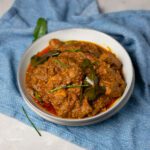


More SMR Herbs


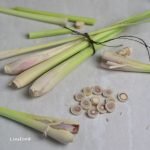

How to Use Kaffir Lime Leaves (Makrut Lime Leaves)
Equipment
- knife or scissors
- chopping board
Ingredients
- Kaffir lime leaves as required
- Fresh coriander leaves can be used instead read article above
Instructions
Cook with Kaffir Lime Leaves
- Tear each side of the leaves from the edges to the centre, but keep them whole.
- See individual recipes but as a general rule, add most of the leaves at the start of the recipe, reserving 2 of them. Add these 5 minutes from the end of cooking time.Adding some leaves at the end of cooking time is optional, it's something I like to do for the strongest aroma. It's not something everyone does.
Recipe Suggestion
Using Kaffir Lime Leaves Raw
- Cut the leaves lengthwise on either side of that harder, tougher middle vein. Then just slice them up thinly or chop them up finely to add to salads and sambals, or even just to flavour up things like salad cream and mayo.



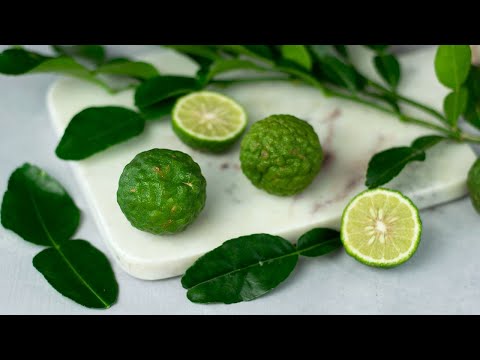
4 thoughts on “What are Kaffir Lime Leaves (+ How to Use Them)”